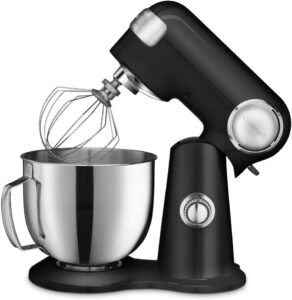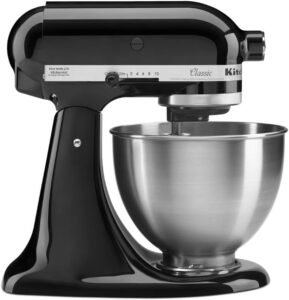The Battle of the Stand Mixers: Cuisinart vs. Kitchen Aid
Introduction
Cuisinart vs. Kitchen Aid. Stand mixers have become an indispensable tool in the modern kitchen, blending functionality with style. In this article, we compare two popular models: the Cuisinart Stand Mixer (12 Speed, 5.5 Quart) and the KitchenAid Classic Series 4.5 Quart Tilt-Head Stand Mixer. Both have their unique features and strengths, and we aim to help you decide which is the best fit for your kitchen.
The quest for the perfect stand mixer is a journey many home chefs and baking enthusiasts embark on. Two major contenders in this arena are the Cuisinart Stand Mixer (12 Speed, 5.5 Quart) and the KitchenAid Classic Series 4.5 Quart Tilt-Head Stand Mixer. Each has its unique features and loyal fan base. In this article, we delve deep into a comparison of these two kitchen stalwarts, examining everything from functionality to design, and performance to price.
Cuisinart vs. Kitchen Aid: Brand Heritage and Design Philosophy
 Cuisinart: Known for introducing the food processor to America, Cuisinart has a reputation for innovation and quality.
Cuisinart: Known for introducing the food processor to America, Cuisinart has a reputation for innovation and quality.
Their 12 Speed, 5.5 Quart Stand Mixer is a testament to this, offering a modern design and versatile functionality.
 KitchenAid: With a history dating back to 1919, KitchenAid’s stand mixers are iconic in the world of kitchen appliances.
KitchenAid: With a history dating back to 1919, KitchenAid’s stand mixers are iconic in the world of kitchen appliances.
The Classic Series 4.5 Quart Tilt-Head Stand Mixer continues this tradition with its timeless design and reliable performance.
Design and Aesthetics
Cuisinart: Features a sleek, modern design. It’s available in multiple colors to match any kitchen decor.
KitchenAid: The Classic Series mixer’s retro design is both functional and visually appealing, making it a statement piece in the kitchen.
Performance and User Experience
Cuisinart: Its powerful motor and larger capacity make it ideal for handling heavy doughs and larger batches.
KitchenAid: Known for its smooth operation and durability. It’s a workhorse that’s effective for a wide range of baking tasks, though it may struggle with very stiff doughs.
Price and Value
- The Cuisinart mixer often comes at a slightly higher price point, but its larger capacity and additional speed settings can justify the cost.
- The KitchenAid is usually more affordable and is renowned for its longevity, often making it a better value in the long run.
Customer Feedback and Market Reputation
- Cuisinart: Users praise its power and versatility, though some note it can be noisier than other models.
- KitchenAid: Enjoys a loyal following, with users commending its reliability and ease of use. However, some users wish for a larger bowl capacity.
Conclusion
Choosing between the Cuisinart and KitchenAid stand mixers depends largely on your specific needs and preferences. If you’re looking for a powerful mixer with larger capacity and more speed options, the Cuisinart is an excellent choice. However, if you prefer a classic design with proven reliability and sufficient functionality for most baking tasks, the KitchenAid Classic Series is a fantastic option. Both mixers offer great quality and performance, making them valuable additions to any kitchen.
Cuisinart vs. Kitchen Aid: Feature Comparison
Capacity and Power:
- Cuisinart: Boasts a 5.5-quart capacity and a motor power that handles a variety of tasks.
- KitchenAid: The 4.5-quart bowl is slightly smaller, but its 275-watt motor is well-suited for everyday baking needs.
Speed Settings and Control:
- Cuisinart: Offers 12 speed settings, giving users fine control over their mixing.
- KitchenAid: Features 10 speed settings, which is sufficient for most recipes.
Attachments and Versatility:
- Both mixers come with standard attachments like a flat beater, dough hook, and wire whip. Cuisinart includes a splash guard, an added convenience.
| Specification | Cuisinart Stand Mixer (12 Speed, 5.5 Quart) | KitchenAid Classic Series 4.5 Quart Tilt-Head Stand Mixer |
|---|---|---|
| Capacity | 5.5 Quarts | 4.5 Quarts |
| Motor Power | 500 Watts | 275 Watts |
| Speed Settings | 12 Speeds | 10 Speeds |
| Bowl Material | Stainless Steel | Stainless Steel |
| Body Material | Die-Cast Metal, Plastic | Zinc, Metal |
| Dimensions (HxWxD) | Varies by model, approximately 15″x14.5″x8.75″ | Approximately 14″x8.7″x13.9″ |
| Weight | Approximately 17 lbs | Approximately 25 lbs |
| Color Options | Multiple color options available | Multiple color options available |
| Tilt-Head/Bowl-Lift Design | Tilt-Head Design | Tilt-Head Design |
| Attachments Included | Chef’s whisk, dough hook, flat mixing paddle, splash guard | Flat beater, dough hook, wire whip |
| Additional Attachments Available | Yes, sold separately | Yes, sold separately |
| Planetary Mixing Action | Yes | Yes |
| Warranty | 3 years limited | 1 year limited |
| Price Range | Premium Pricing, varies by retailer | Generally mid-range, varies by retailer |
| Unique Features | Larger bowl capacity, more speed settings | Classic design, robust construction, less weight |
Cuisinart vs. Kitchen Aid: Detailed Performance Analysis
Mixing Efficiency:
- Cuisinart: Its 12-speed settings allow for unparalleled precision. Whether it’s gently folding ingredients or vigorously kneading bread dough, the mixer adapts effortlessly. The power is a standout feature, especially for those who regularly work with tough doughs or large quantities.
- KitchenAid: The 10-speed range is competent for most tasks. Its mixing action, where the beater spins in one direction while whisking and turning in the other, ensures thorough blending of ingredients. This feature is particularly effective for tasks like creaming butter and sugar, or achieving smooth cake batters.
Noise Level:
- Cuisinart: Some users have noted that it operates with a bit more noise, especially at higher speeds. This could be a consideration for those who prefer a quieter kitchen environment.
- KitchenAid: Tends to be quieter, a plus for users who are sensitive to appliance noise.
Cuisinart vs. Kitchen Aid: Durability and Longevity
Build Quality:
- Cuisinart: Constructed with a focus on durability. Its heavy-duty motor is designed to withstand frequent use, and the mixer’s overall construction feels solid and robust.
- KitchenAid: The all-metal build is one of its strongest selling points. These mixers are often passed down through generations, highlighting their lasting durability.
Long-Term Use:
- Cuisinart: Users report that it stands up well to regular use, although longevity can vary depending on usage patterns.
- KitchenAid: Known for its reliability over many years. It’s not uncommon to hear of KitchenAid mixers lasting decades with proper care.
Cuisinart vs. Kitchen Aid: Additional Features and Accessories
Flexibility:
- Cuisinart: Offers additional attachments (sold separately) like pasta rollers, meat grinders, and more, increasing its utility in the kitchen.
- KitchenAid: Also has a wide range of available attachments, making it a multifunctional appliance beyond just mixing.
Ease of Cleaning:
- Cuisinart: Components are generally dishwasher safe, making cleanup straightforward.
- KitchenAid: Similar ease of cleaning, with most attachments being dishwasher safe.
Price-to-Performance Ratio
- Cuisinart: Its higher price point is offset by its larger capacity and more powerful motor. For those who bake in larger quantities or need the extra power, the investment can be well worth it.
- KitchenAid: Offers excellent value for money, considering its performance and durability. It’s a solid investment for regular home bakers.
Market Trends and Consumer Preferences
- Trends show a growing interest in versatile kitchen appliances, and both mixers cater to this demand. The KitchenAid, with its timeless design, appeals to those who appreciate classic kitchen aesthetics, while the Cuisinart’s modern features attract a tech-savvy crowd.
Cuisinart vs. Kitchen Aid: Final Recommendations
When it comes down to choosing between the Cuisinart and KitchenAid, consider your specific needs:
- For heavy-duty baking and larger batches: The Cuisinart’s larger capacity and powerful motor make it the better choice.
- For everyday baking and a classic kitchen look: The KitchenAid is a reliable, efficient, and aesthetically pleasing option.
Both the Cuisinart and KitchenAid stand mixers are exceptional in their own rights. They embody the perfect blend of functionality, design, and reliability, setting a high standard in the world of kitchen appliances. Your final choice will depend on your individual baking needs, kitchen space, design preference, and budget. With either of these mixers, you can look forward to many years of joyful baking and culinary exploration.

Leave a Reply